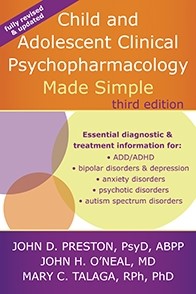


By
John Preston, Psy.D., ABPP
John H. O’Neal, MD
Mary C. Talaga, R.Ph., Ph.D.
Child and Adolescent Clinical Psychopharmacology Made Simple offers everything you need to know about the use of psychoactive medications in the treatment of childhood and adolescent psychological disorders in easy-to-understand language. This fully revised third edition offers updated DSM-V definitions, new information regarding teen use of antidepressants and suicidality, information on attention deficit/hyperactivity disorder (ADHD) and ADHD medications, bipolar disorder, psychotic episodes and eating disorders in children and adolescents, the use of antipsychotics in children and adolescents, non-medication approaches and adjuncts to medications, and how to assess and treat noncompliance and "breakthrough" symptoms. Also included are fact sheets that clearly delineate frequently prescribed medications for each disorder along with medication side effects and signs of toxicity. For each psychological disorder, the book offers: current diagnostic criteria; treatment indications and contraindications; medication information; and help for monitoring, evaluating, and following up with patients. Whether you are a pediatrician, parent, therapist, educator, or other health care professional, this is the only resource you need to consult for the most up-to-date information on child and adolescent medications and treatment.
John Preston, Psy.D., ABPP,is a licensed psychologist and author or coauthor of twenty books. He is professor emeritus of psychology at Alliant International University, and has also served on the faculty of the UC Davis School of Medicine. He has lectured widely in the United States and abroad. He is the recipient of the Mental Health Association’s President’s Award for contributions to the mental health professions, and is a fellow of the American Psychological Association.
John H. O’Neal, MD,, is a board-certified psychiatrist who has been in private practice since 1977. He is past chief of the department of psychiatry at Sutter Community Hospital in Sacramento, CA. He is associate clinical professor of psychiatry at the UC Davis School of Medicine, and a fellow of the American Psychiatric Association. He lectures on depression and psychopharmacology to mental health professionals, employee assistance programs, and the public. O’Neal received his Masters in clinical psychology from Harvard University, and Doctor of Medicine from the University of Washington.
Mary C. Talaga, R.Ph., Ph.D.,, has been a pharmacist for thirty-nine years, with specialization in psychiatric pharmacy and pharmacy administration. She has extensive experience in health care, and has practiced in a variety of clinical settings. Over her career, she has contributed to the development of best practice guidelines, and has promoted collaborative care models. She has provided training and mentoring to health care professionals, and education to patients and consumers.
After completing this course you’ll be able to:
| 1. | Discuss the mental illnesses that begin in childhood. |
| 2. | Describe the four concerns when children are prescribed medication treatment. |
| 3. | Discuss the use of medications and the influence of the media. |
| 4. | Describe how medications are metabolized in children. |
| 5. | List signs and symptoms of major depression in children. |
| 6. | Discuss the Treatment for Adolescents with Depression Study. |
| 7. | Describe guidelines for pharmacological treatment of depression. |
| 8. | State how to avoid withdrawal symptoms. |
| 9. | Discuss diagnosis of early-onset bipolar disorder. |
| 10. | Discuss bipolar disorders and comorbidities. |
| 11. | Describe the kindling model. |
| 12. | Discuss relapse prevention studies. |
| 13. | Describe obsessive-compulsive disorder. |
| 14. | Discuss post-traumatic stress disorder. |
| 15. | List the factors that support a neurobiological basis for OCD. |
| 16. | Describe the amygdale. |
| 17. | Define psychotic, delusions, and hallucinations. |
| 18. | Describe the three phases of schizophrenia. |
| 19. | Discuss the dopamine model. |
| 20. | Describe extrapyramidal side effects. |
| 21. | Describe pharmacological treatment of psychotic disorders. |
| 22. | Describe ADHD and how the diagnosis is made. |
| 23. | Discuss the use of stimulants to treat ADHD. |
| 24. | Define medication rebound. |
| 25. | Discuss the major drawbacks of stimulants. |
| 26. | Discuss autism. |
| 27. | Compare Asperger’s disorder with Rett’s disorder. |
| 28. | Discuss several medications for pervasive developmental disorders. |
| 29. | Describe Tourette’s syndrome and the treatment. |
| 30. | Describe the three main types of eating disorders and the treatment. |
| 31. | Compare substance dependence and substance abuse. |
| 32. | Discuss several substances that are abused. |
| 1. | Issues in Psychopharmachological Treatment of Children and Adolescents |
| 2. | Depression |
| 3. | Bipolar Disorder |
| 4. | Anxiety |
| 5. | Psychotic Disorders |
| 6. | Attention-Deficit/Hyperactivity Disorder |
| 7. | Autism Spectrum Disorders |
| 8. | Miscellaneous Disorders |
© 2007 - 2010 Homestead Schools, Inc. - Webmaster: ITSYS Solutions